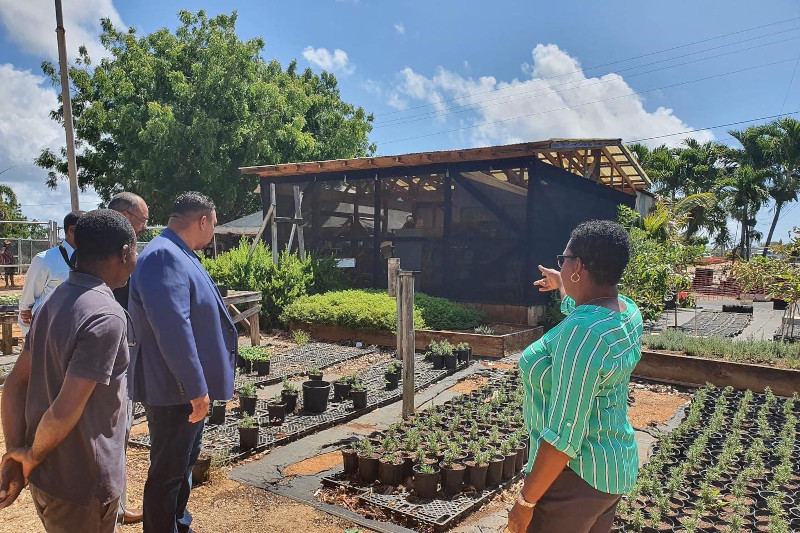Ministry of Planning, Agriculture, and Housing
Leading the Cayman Islands’ Bold Stride Towards Sustainable Development and Inclusivity
Setting a new benchmark in sustainable agriculture, digital infrastructure, housing, and community revitalization
Guided by the leadership of Hon. Jay Ebanks, the Ministry of Planning, Agriculture, and Housing is a key institution in the Cayman Islands. It has evolved into a multi-dimensional entity, addressing integrated development with a focus on sustainable agriculture, affordable housing, infrastructure and development, and environmental conservation.
The ministry’s daily operations are as dynamic as its scope, involving policy formulations, project management, and stakeholder collaborations to ensure strategic objectives are effectively met. “Our day-to-day operations involve our policy for formulations, project management, and collaborations with our daily stakeholders to ensure the strategic objectives are effectively met,” states Minister Ebanks, highlighting the multifaceted nature of the ministry’s work.
Food Security and Agricultural Innovation
In a world where sustainability and self-sufficiency are increasingly at the forefront of national agendas, the Cayman Islands is taking significant strides under the guidance of Minister Ebanks. Initiating the Cayman Islands Food and Nutrition Security Policy alongside the LEADS program will enhance the nation’s food sovereignty and agricultural vitality.
The minister provides an overview of the driving force behind these pivotal programs. “When we think of food nutrition and the direction the world is heading, we found it imperative to create the first-ever Food Nutrition Policy for the Cayman Islands,” he states. He says this policy was a mere addition to the ministry’s portfolio and a necessary stride toward ensuring the country’s sustainable food and nutrition security development. “It took some time to get done, but it was needed if we wanted to develop and move in the right direction,” he reflects.
Going deeper into the specifics, Minister Ebanks sheds light on how the policy branches into various sectors of agriculture, a domain close to his heart. “One thing that is very dear to my heart is agriculture… and there’s no better way of having better nutrition than to know what you have grown and can supply yourself,” he articulates. This philosophy of ‘eating what you grow’ champions the cause of health and nutrition and emphasizes the importance of self-reliance in a country’s food production capabilities.
Minister Ebanks also highlights the innovative LEADS program intricately linked to the Food and Nutrition Security Policy. While detailing the initiatives under this program, he points out, “Our focus on the poultry sector as a quick win shows our commitment to achieving self-sufficiency in egg production, aiming for a 40% reduction in imports.” This ambition signifies a broader strategy to reduce dependency on imported goods and ensure that the imports are of high quality, non-GMO, and contribute positively to the health of the Cayman Islands’ residents.
Towards Enhanced Road Safety and Digital Infrastructure
As the Cayman Islands continues to evolve, both in terms of its societal needs and technological advancements, the government is laying down significant plans to address these changing dynamics. Two critical focus areas are the implementation of a comprehensive National Road Safety Strategy and the development of state-of-the-art subsea fiber cables to bolster the nation’s digital infrastructure.
Minister Ebanks begins with an overview of the National Road Safety Strategy, emphasizing its genesis against a backdrop of concerning accident rates. “Our national road safety strategy has come to the forefront of the government, looking back at the many accidents we have had throughout the years,” he explains. This strategy aims to eliminate road fatalities by 2038 and encapsulates a vision for a safer Cayman through the ‘Road to Zero’ initiative.
The minister highlights the multifaceted approach of the strategy, focusing on the ‘four Es’: Engineering, Educating, Enforcement, and Emergency Response, with a particular emphasis on education. “Our priority is education,” he notes, stressing the importance of cultivating a safety culture and responsibility among road users.
Shifting to the digital infrastructure of the Cayman Islands, Minister Ebanks discusses the progress of the subsea fiber cable project, which is essential for supporting the country’s largest industry, financial services. “The subsea cable is progressing very well… we are going through probably our final stages now,” he elaborates. The strategic direction of this project—whether to build a new cable, enter a partnership, or purchase a spur from an existing cable—is critical for ensuring the nation’s competitive edge in the global financial sector. The urgency of this project is driven by the nearing life expectancy of the current Myo One cable.

Addressing the Housing Crunch with Innovative Solutions
The affordable housing crisis is not unique to the Cayman Islands but a global challenge that nations grapple with. In the Cayman Islands, however, the government is confronting this issue head-on, adopting innovative and sustainable approaches to provide homes and ensure they are within the financial reach of its citizens. Minister Ebanks sheds light on the multifaceted nature of this challenge and the government’s proactive stance in addressing it.
“Housing is a big thing here for this government,” he asserts, emphasizing the commitment to delivering “the best affordable house we can deliver for our people.” This dedication ensures that the homes are affordable and built to the highest sustainability and durability standards, with features like state-of-the-art air conditioning systems, spray foam insulation, and energy-efficient windows. “It’s a Cat five category infrastructure that we’re building,” the minister points out, highlighting the homes’ resilience to severe weather conditions, a crucial consideration given the region’s vulnerability to hurricanes.
The scale of the government’s housing initiative is impressive, with plans to roll out numerous homes across various constituencies. “We’re doing several houses, building out with doing 45 in the constituency of Northside, which is my constituency,” Minister Ebanks notes. This effort is not just about building houses; it’s about building communities and providing residents with the gift of homeownership, as evidenced by the planned handover of keys to new homes in time for Christmas in West Bay.
Furthermore, Minister Ebanks notes the government’s holistic approach to housing beyond construction, including land development and repairs. “We won’t only just be doing housing and building houses; we actually do housing repairs, but we are also going to start to develop or just sell the land lots,” he explains. This strategy aims to cater to the population’s diverse needs, recognizing that not everyone desires a pre-built home. By making land available at affordable prices, the government is empowering its citizens to build their homes according to their preferences and financial capabilities.
Reimagining Georgetown: A Blend of Modernity and Heritage
Georgetown, the vibrant heart and capital of the Cayman Islands, stands on the brink of transformation. Traditionally known as a bustling business district, this central hub has experienced a noticeable decline in urban vibrancy and cultural appeal. Recognizing the need for rejuvenation, the government has embarked on an ambitious plan to breathe new life into Georgetown, aiming to restore its allure as a community hub where nightlife, business, and leisure harmoniously coexist.
“Right now, we’re only looking at revitalizing Georgetown, our central capital, our hub of the Cayman Islands,” Minister Ebanks says. He reflects on the perception that Georgetown has become merely a business capital, lacking in nightlife and becoming somewhat of a ghost town after hours. “How do we revitalize Georgetown and make people want to be there after hours?” he poses, highlighting the core challenge the project aims to address.
The strategy for revitalizing Georgetown involves a phased approach, with the initial phase focusing on Cardinal Avenue. “Our first phase was looking at Cardinal Avenue, which was a street connecting a lot of the businesses down there, and it is a historic street,” Minister Ebanks explains.
The objective was to transform the street into a more inviting space, encouraging people to engage with the area in various ways, from leisurely reading a book to enjoying casual interactions in a more aesthetically pleasing environment. Despite initial resistance to the idea of closing a section of the road, the project’s completion has garnered widespread acclaim, proving the value of the initiative and setting the stage for further developments.
With the successful completion of the first phase, the government has committed to continuing this revitalization with a second phase already underway. “The government was committed to doing a second phase in the Georgetown revitalization, which we have just recently started,” Minister Ebanks shares.
This ongoing effort is not merely about modernization; it’s about intertwining the Cayman Islands’ history and culture into the fabric of Georgetown. “What we want to do is continue the phased approach and how we modernize, but also wanting to leave a bit more of our history and culture,” the minister notes.

Envisioning the Future: Priorities for 2024 and Beyond
As the Cayman Islands looks toward 2024, the government’s agenda is brimming with ambitious initiatives to advance sustainable development, enhance digital connectivity, ensure food security, and, most significantly, address the housing crisis.
Anne Kensington-Lott, Head of Communications and Public Relations, stepping in to provide insights into the government’s top initiatives for the upcoming year, emphasizes the significance of bringing ongoing projects to fruition. “I think for 2024, through the next two years, it is completing all the different projects that we’ve started,” she states, highlighting the broad spectrum of initiatives that span vital sectors such as agriculture, digital infrastructure, and housing.
Kensington-Lott further elaborates on the importance of the housing sector, indicating that it will be at the forefront of the government’s agenda. “Housing is a very large one,” she notes, referring to the multifaceted strategy encompassing expanding the National Housing Development Trust homes and providing Caymanians with land to build on. This dual approach will offer residents more flexibility and choice, recognizing the community’s diverse needs and preferences. “That’s going to be a main initiative as we move forward into 2024,” Kensington asserts, underlining the government’s devotion to tackling the housing challenge with innovative and inclusive solutions.
As the Cayman Islands advance into 2024, the government’s agenda reflects a balanced blend of completing existing projects and laying the groundwork for new initiatives. By focusing on critical areas such as housing, agriculture, digital infrastructure, and community development, the government addresses immediate needs and prepares for the future. This strategic vision, coupled with sustainability, inclusivity, and innovation efforts, sets a promising trajectory for the Cayman Islands, ensuring its continued prosperity and resilience in the face of evolving global challenges.
AT A GLANCE
Ministry of Planning, Agriculture, and Housing
What: A government entity dedicated to guiding sustainable development across various sectors, including agriculture, housing, infrastructure, and environmental conservation in the Cayman Islands.
Where: Cayman Islands
Website: https://www.gov.ky/pahi/home




 This information will never be shared to third parties
This information will never be shared to third parties